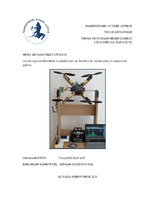| dc.contributor.advisor | Chatzopoulos, Avraam | |
| dc.contributor.author | Γαλάνης, Παύλος | |
| dc.date.accessioned | 2024-04-15T10:05:28Z | |
| dc.date.available | 2024-04-15T10:05:28Z | |
| dc.date.issued | 2023-04 | |
| dc.identifier.uri | https://polynoe.lib.uniwa.gr/xmlui/handle/11400/6491 | |
| dc.identifier.uri | http://dx.doi.org/10.26265/polynoe-6327 | |
| dc.description.abstract | Η παρούσα διπλωματική αφορά τη σχεδίαση και ανάπτυξη ενός πρωτότυπου τετρακόπτερου για χρήση σε εκπαιδευτικές δραστηριότητες. Το τετρακόπτερο είναι χαμηλού κόστους και το πλαίσιο του είναι μια ρεπλίκα του DJ1 Flame Wheel 450 (F450), υλοποιήθηκε με τον μικροελεγκτή Arduino Nano και έχει σαν αδρανειακές μονάδες τις MPU-6050 και MPU- 9250. Τα μοτέρ είναι τύπου brushless τα οποία ταιριάζουν με προπέλες μήκους 10 ιντσών και 4.5΄΄ βήμα. Η μπαταρία του είναι τύπου Lipo 3Cells, χωρητικότητας 2600 mAh. Το τετρακόπτερο είναι εξοπλισμένο με μονάδα GPS της οποίας τα δεδομένα στέλνονται ασύρματα, με την βοήθεια του πομποδέκτη HC-12, σε φορητό υπολογιστή ο οποίος απεικονίζει σε γραφικό περιβάλλον τα δεδομένα με το πρόγραμμα U –Center, της U-Blox . Επιπρόσθετα έχει ενσωματωθεί ο αισθητήρας της Bosch, BMP280, ο οποίος παρέχει δεδομένα υψομέτρου και θερμοκρασίας. Τέλος χρησιμοποιείται ο πομποδέκτης nRf24 ο οποίος αποστέλλει σε πραγματικό χρόνο χαρακτηριστικά της πτήσης σε αυτόνομο σταθμό βάσης αλλά και στον φορητό υπολογιστή. Στην βασική του διαμόρφωση έχει την δυνατότητα ανύψωσης φορτίου (payload) έως 700gr. Για τους αρχικούς πειραματισμούς και την σταθερότητα του προγράμματος ελέγχου πτήσης, τις ρυθμίσεις του τετρακόπτερου και την ασφάλεια του εξοπλισμού αλλά και του χρήστη, το drone προσαρμόζεται σε ειδική ξύλινη βάση . Η βάση είναι αυτόνομη, έχει το δικό της αδρανειακό σύστημα μέτρησης και στέλνει ασύρματα δεδομένα για τις γωνίες του drone σε φορητό υπολογιστή. Τροφοδοτείται από εξωτερική πηγή (τροφοδοτικό ή μπαταρία). | el |
| dc.format.extent | 180 | el |
| dc.language.iso | el | el |
| dc.publisher | Πανεπιστήμιο Δυτικής Αττικής | el |
| dc.rights | Αναφορά Δημιουργού - Μη Εμπορική Χρήση - Παρόμοια Διανομή 4.0 Διεθνές | * |
| dc.rights.uri | https://creativecommons.org/licenses/by-nc-sa/4.0/deed.el | * |
| dc.subject | Τετρακόπτερο | el |
| dc.subject | Τηλεμετρία | el |
| dc.subject | Μονάδα μέτρησης αδράνειας | el |
| dc.subject | PID controller | el |
| dc.subject | Εκπαιδευτική πλατφόρμα | el |
| dc.subject | Quadcopter | el |
| dc.subject | Telemetry | el |
| dc.subject | Inertial measurement unit | el |
| dc.subject | IMU | el |
| dc.subject | Educational platform | el |
| dc.title | Ανάπτυξη εκπαιδευτικού τετρακόπτερου με δυνατότητα τηλεμετρίας σε πραγματικό χρόνο | el |
| dc.title.alternative | Development of an educational quadcopter with telemetry capability in real time | el |
| dc.type | Μεταπτυχιακή διπλωματική εργασία | el |
| dc.contributor.committee | Παπουτσιδάκης, Μιχαήλ | |
| dc.contributor.committee | Papakitsos, Evangelos | |
| dc.contributor.faculty | Σχολή Μηχανικών | el |
| dc.contributor.department | Τμήμα Μηχανικών Βιομηχανικής Σχεδίασης και Παραγωγής | el |
| dc.contributor.master | Μη Επανδρωμένα Αυτόνομα και Τηλεκατευθυνόμενα Συστήματα (MSc Unmanned Autonomous and Remote Controlled Systems) | el |
| dc.description.abstracttranslated | This thesis concerns the design and development of a prototype quadcopter for educational purposes. The quadcopter is low-cost, its frame is a replica of the DJ1 Flame Wheel 450 (F450), it is implemented with the Arduino Nano microcontroller and has the MPU-6050 and the MPU-9250 as inertial units. The motors are of brushless type, which match with 10-inch-long propellers, 4.5΄΄ pitch. Its battery is of the Lipo 3Cells type, with a capacity of 2600 mAh. The quadcopter is equipped with a GPS unit whose data are sent wirelessly, with the help of the HC-12 transceiver, to a laptop computer which displays the data in a graphical environment with the U-Blox program, U-Center. In addition, the Bosch BMP280 sensor has been implemented giving altitude and temperature data. Finally, the nRf24 transceiver is used to send real-time data of the flight to an autonomous base station and to the laptop computer. The Quadcopter in its base configuration can lift a load up to 700gr(payload). Τhe drone will be adapted to a special wooden base so as to be ensured during the initial experiments, the stability of the flight control program, the settings of the quadcopter as well as the safety of the equipment and the user. The base is autonomous, it has its own inertial measurement system and is sending wirelessly the data of the drone's inclination to a laptop computer. It is powered by an external source (power supply or battery). | el |



